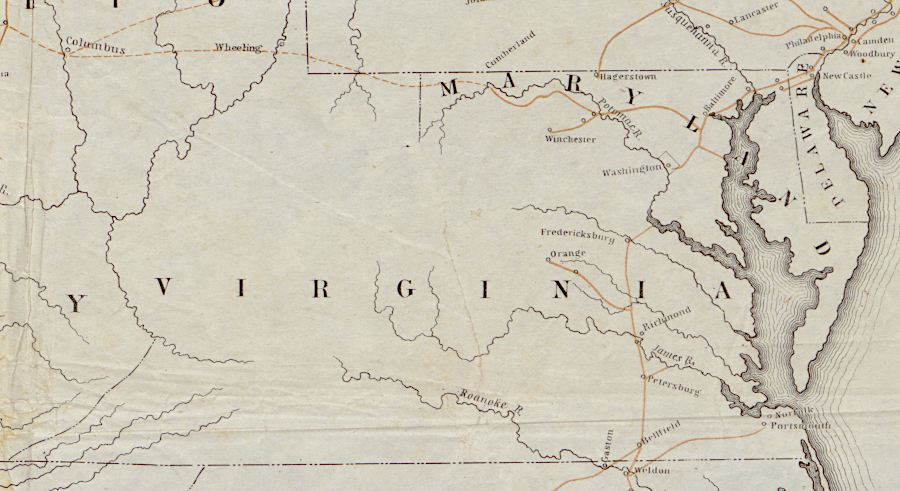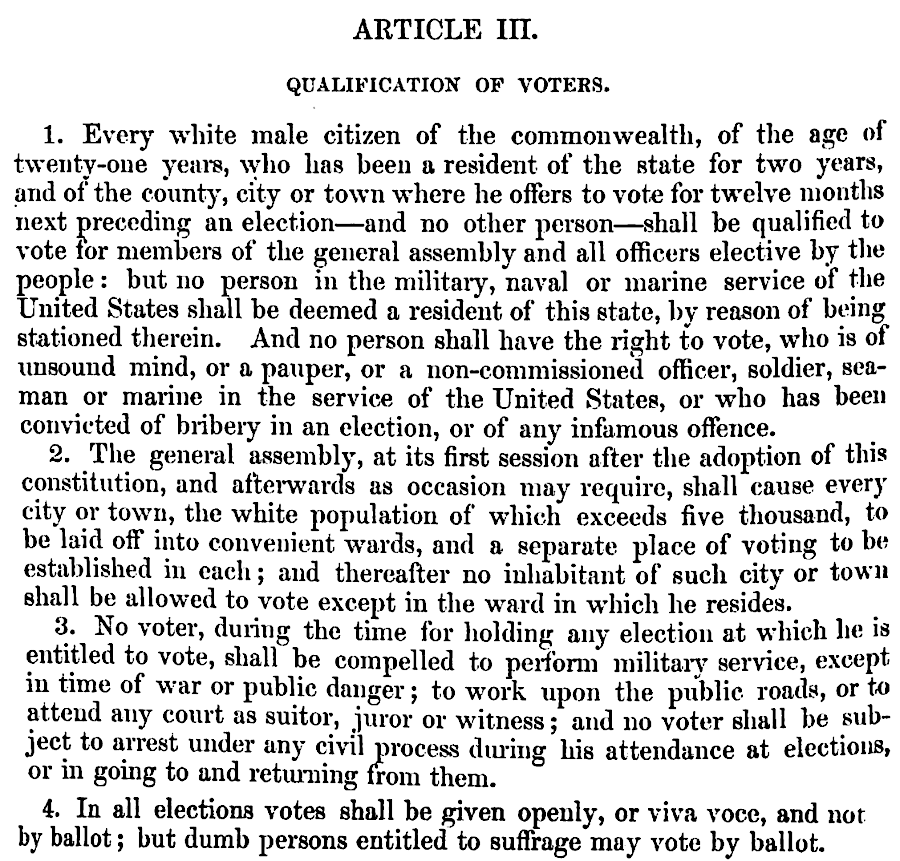
in 1848, railroads in Virginia were concentrated east of the Blue Ridge
Source: Library of Congress, Skeleton map showing the Rail Roads completed and in progress in the United States (1848)

in 1848, railroads in Virginia were concentrated east of the Blue Ridge
Source: Library of Congress, Skeleton map showing the Rail Roads completed and in progress in the United States (1848)
Another convention, meeting between October 14, 1850 - August 1, 1851, wrote Virginia's third constitution. The delegates took a break between the two session, held October 14-November 4, 1850 and January 6-August 1, 1851.
The 1851 constitution finally eliminated the requirement of voters to own a certain amount of property and established universal, white manhood suffrage. With a few exceptions, all white males over 21 years of age who met the residency requirements became eligible to vote. "Freehold" voting was an objective primarily of western Virginians, since a higher percentage of them had been blocked from voting by the property minimums in the 1776 and 1830 constitutions. Women and people of color remained unable to vote.
Ministers remained ineligible to serve in the House of Delegates or State Senate:1
The executive branch structure was revised by eliminating the role of the General Assembly in choosing the governor, and holding direct elections for that position. The Council of State, originally eight people elected by the legislature in the 1776 constitution and then three people in the 1830 constitution, was completely eliminated.
In the colonial era and under the previous two constitutions, if a governor died or resigned his office before completing his term, the longest-serving member of the Council of State would serve until the General Assembly met and choose a new governor. Abolishing the Council of State eliminated that possibility, so the new constitution created the elected position of Lieutenant Governor so the voters would determine the replacement.
Prior to 1851, eight times a member of the Council of State had assumed the role of governor. Council of State members became acting governors seven times after a resignation, and once after Governor George William Smith bdied in office during the December 26, 1811 Richmond Theater Fire.
Since 1851, no Lieutenant Governor has replaced a governor who did not complete their term. However, during Reconstruction after the Civil War, the Federal commanders of Military District No. 1 forced two governors to resign. The military governors appointed "provisional governors" to replace them; no Lieutenant Governor was elevated to serve as governor.
The 1851 constitution also gave voters the right to elect the Attorney General, as well as the Governor and Lieutenant Governor. If an election for those offices was contested, or if a vote ended in a tie, the General Assembly retained the authority to determine the winner. That provision remains in the current state constitution.2
The power of local residents was increased by having direct elections for local officials - clerk of the county court, surveyor, commonwealth attorney, sheriff, commissioners of the revenue, constables, and overseers of the poor. Term limits were imposed on sheriffs. A sheriff could be elected for just two sequential terms, and could not serve in any political office for a year after the second term ended.
Voters also elected judges of the Supreme Court of Appeals, circuit court, and county courts. The constitution required that counties be divided into districts, each of which would elect four justices of the peace. Those justices formed the county court and handled a mix of legislative, executive, and judicial functions.
The General Assembly had appointed all judges since counties were first created in 1634. In practice, the county courts were an aristocratic bastion controlled by the wealthy property owners in a county. Whenever there was a vacancy, the other members of the county court recommended the replacement and the governor/legislature routinely appointed that person.3
The number of General Assembly sessions were cut in half, by shifting from annual to biannual meetings. Time limits were also defined for the biannual session. The change to biennial sessions eliminated the annual election process. After adoption of the new state constitution, the first election for a new General Assembly was in 1851. Ever since, Virginia has held elections for Federal officials in even-numbered years and for state officials in odd-numbered years.
In the 1851 state constitution, the State Senate gained power equal to the House of Delegates. Prior to the new constitution, the State Senate could not originate legislation; it could only amend proposals generated in the House of Delegates. The 1851 constitution said:4
The decisions to reduce the legislature's power reflected sectional rivalries, as well as a public demand for greater democracy that had been building since the election of President Andrew Jackson in 1828. Western Virginans wanted less control by the General Assembly, since it was dominated by delegates and state senators elected from districts located east of the Blue Ridge.
In the 1850-1851 constitutional convention, westerners again failed to get voting districts realigned enough to overcome the dominance of the General Assembly by voters living east of the Blue Ridge. In the 152-member House of Delegates, 66 seats (43%) were allocated to districts west of the Blue Ridge. The percentage of western districts in the State Senate was lower, at 38%. In that 50-member body, only 19 State Senators would be elected from west of the Blue Ridge.
New language was added to prevent the creation of new counties smaller than 600 square miles. The large minimum size was intended to limit the number of new members that would be elected to the House of Delegates as new counties were created. Today, only nine counties in Virginia exceed 600 square miles in size:5
- Pittsylvania (968.94 sq mi)
- Augusta (967.00 sq mi)
- Rockingham (849.08 sq mi)
- Halifax (817.84 sq mi)
- Bedford (753.02 sq mi)
- Albemarle (720.70 sq mi)
- Franklin (690.43 sq mi)
- Fauquier (647.45 sq mi)
- Mecklenburg (625.48 sq mi)
Eastern landowners were unwilling to give up their guarantee of legislative control that was enshrined in the 1830 constitution. Easterners continued to cite their justification of excessive representation for districts east of the Blue Ridge, based on the claim that government was responsible for protecting property and the greatest property values were east of the mountains.
Easterners also feared that westerners might be more willing to accept emancipation of enslaved people in the future, since the vast majority of such "property" was located east of the mountains.
The 1851 constitution did include a requirement for the General Assembly to reapportion how its members would be elected 15 years in the future. That provided a temporary resolution of the heated controversy regarding how voters in eastern Virginia had a greater share of elected representatives compared to voters in western Virginia.
If the General Assembly could not reach a reapportionment deal in 1865 and every ten years afterwards, the 1851 constitution required to governor to organize an election so voters could resolve the redistricting issue directly. The choices would involve districts with boundaries drawn to equalize just the white population, and districts with boundaries drawn on a "mixed basis" to balance both the white population and the assessed value of property within the district.
The power of the eastern bloc enabled it to protect slaveowners in Tidewater and the Piedmont from the threat of confiscatory taxation. The 1851 constitution required that all property had to be taxed at the same rate, and "property" included enslaved people that were more common east of the Blue Ridge.
If the General Assembly increased the tax rate to raise more revenue from wasterners who owned slave property, then the tax rate would increase just as much on land owned by farmers without slaves. More significantly, the constitution also defined a $300 cap on the value of enslaved adults and prohibited any tax on people less than 12 years old, ensuring the tax burden would fall primarily upon western landowners:6
Those provisions ended up subsidizing slaveowners, as the value of their "property" grew far beyond those caps throughout the 1850's. The western residents, who owned fewer enslaved people, paid an increasing percentage of the state property tax because of the $300 cap. Dissatisfaction reached the point where westerners discussed splitting the state.
The new constitution was ratified by the voters on October 24, 1850. It went into effect on January 12, 1851.7
The 1851 constitution created no mechanism for amendments, except for apportionment. A new constitutional convention would be required, if voters wanted to change anything other than the basis for drawing boundaries of voting districts.

the 1851 Constitution eliminated the property ownership requirement and allowed more white men to vote
Source: Hathi Trust, Code of Virginia, 1860